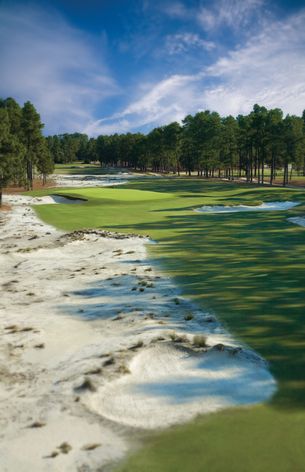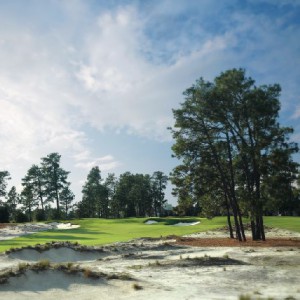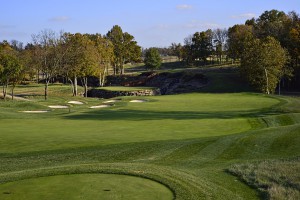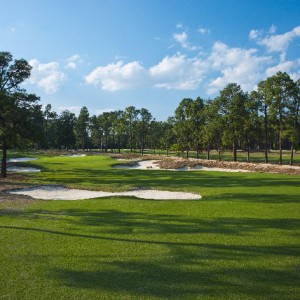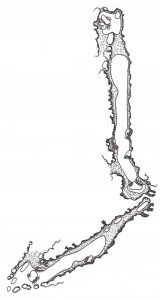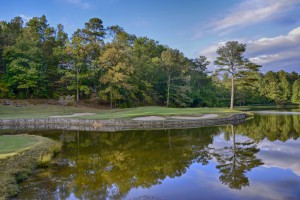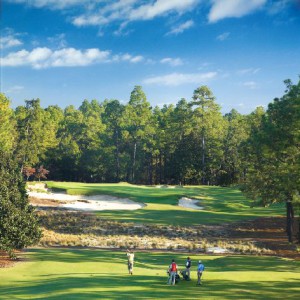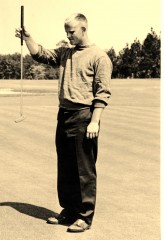
Nicklaus won the North and South on Pinehurst Number 2 in 1959, launching a life-long attachment to the great Donald Ross design.
Bill Coore and Ben Crenshaw deserve kudos for their restoration of Pinehurst #2. Their exertions amount to an extended homage to the genius of Donald Ross. The rejuvenation was overdue. As long ago as 1974, when he was playing in the World Open Championship on #2, Jack Nicklaus said he was “shocked” that the course’s new owners “had grassed in the famous sandy waste areas bordering the fairways [and] converted the greens from Bermuda to bent grass.” Despite his dismay with the obliteration of #2’s “raggedy” character (as well as his second place finish), Nicklaus nonetheless remarked to Dan Jenkins that he had “never enjoyed playing a golf course more. I learned at least five things about design this week, and on a golf course more than fifty years old.”
Asked recently what “five things about design” he had learned, Nicklaus demurred. He had been speaking figuratively. But he offered a clue when he observed that the absence of water and trees as strategic hazards had “still shown through,” despite the imprudent modifications. He understood that Ross’s best designs were restrained and subtle, not brash or gaudy. Pinehurst’s #2 was Ross’s magnum opus, subject to countless revisions and improvements during the decades Ross lived and worked in North Carolina. Nicklaus’s pattern of continual improvements to Muirfield Village echoes Ross’s polishing at Pinehurst.
The Ross course where Nicklaus learned to play, Scioto, had “deteriorated badly” by the late 1950s. The club hired Dick Wilson “to do some rejuvenation.” Nicklaus remembered “following him around the course and listening to his ideas.” The final result, however, was not the hoped-for “rejuvenation,” Nicklaus recalled, but a “redesign” which “un-Rossed” the course, just as Pinehurst #2 would be shorn of its personality a few years later when its sandy wastes were grassed over. In 1974, when he was 34, Nicklaus established his own design firm. Nicklaus was “spending just about as much time and effort designing golf courses as playing them” by then, although it’s a measure of his greatness that he would still go on to win six more majors, completing a third career grand slam. Famously analytical as a player, Nicklaus would bring his fastidious intelligence and deep knowledge of the game to golf design, and by looking for echoes of Ross’s genius in Nicklaus’s portfolio, we can begin to assess the master’s influence on his most formidable and famous devotee.
ROSS PRINCIPLE #1: An “Easy” Start
Ross Example: First hole, Pinehurst # 2. Open yardage: 402, par 4.
“Give the player a chance to warm up a bit,” Ross said of Number 2’s opener.
Nicklaus was also enamored of the shrewd challenge of this hole, with its “medium-sized green guarded by only one bunker situated to the left of the green and extending three-quarters of the way back.” If they “play away from this bunker,” however, players may “end up in the pronounced hollow to the right of the green. Then they face a much more difficult shot than the one they would have had from the bunker, for the hollow is filled with undulations, and it takes an exquisite touch chip to run the ball up the bank at just the right speed and have it roll dead near the cup. If Donald Ross had put in a second bunker to the right of the green–and most architects would have–it would have made the hole blunter, easier, and much more prosaic.”[1]
Nicklaus Example: Shoal Creek. Major yardage: 401, par 4.
Known as “the Starter,” Shoal Creek’s first is “one of the easiest holes on the course. The fairway is fairly narrow and the green is nestled behind two medium sized bunkers.”
Shoal Creek was the first of Jack Nicklaus’s courses to host a major championship when the 1984 PGA Championship was held there under controversial circumstances. The course’s developer had defended the club’s lily-white membership, which was politically volatile although it had nothing to do with the quality of the course, which is universally regarded as one of the region’s finest. There are few if any prominent southern country clubs which can lay claim to a history of progressive racial policies. Pinehurst was as segregated as any other southern resort until the 1960s, but that fact doesn’t taint Donald Ross’s legacy any more than Shoal Creek’s former policy tarnishes Nicklaus, who created a great championship venue at Shoal Creek.
ROSS PRINCIPLE #2: Create a “short but demanding” par 4, ideally playing uphill to a small green.
Ross Example: Hole 13, Pinehurst # 2. Open Yardage: 385, par 4.
The best example of a short par 4 at Pinehurst is 13, which plays slightly uphill—a modest twenty-five feet of elevation change over 385 yards. Unlike Nicklaus’s 13th at Valhalla, which is slightly shorter at 355 yards, Pinehurst’s best short hole is defended entirely by the bunkers and the contour of the green, in typical Ross fashion. The neck of the hole is thirty-five yards wide, with a fifteen yard wide Adam’s apple between guardian bunkers on the right and what’s being referred to as the restored “sandy floor” on the left. Imagine the profile of someone with a weak chin lying on his back to get a sense of the contours of 13. If a player’s shot doesn’t edge its way up to the chin, it’s going to roll back down to the chest. The bunkers have defined edges and are raked, while the sandy floors may have pine straw, wispy grass or other impediments to a useful lie. The 13th green sits atop a ridge which it shares with the 14th tee, giving that hole a downhill path which mirrors 13th’s ascent. The green’s area is only about 3,600 square feet.
Nicklaus Example: 13th at Valhalla, Site of 1996, 2014 PGA Championship
Valhalla’s 13th hole played an exhilarating role in the 2008 Ryder Cup, because it sits at a pivotal point for match-play. Unlike Ross’s 13th, which seems benign but can bite, Valhalla’s 13th has bared fangs. The hole is only 355 yards, but the green sits securely behind a moat, perched on a rocky rampart. At roughly 5,200 square feet, Valhalla’s green is a bit larger than the 13th at Pinehurst, but there is no room for error. The green tilts slightly from left to right, which means it can hold a slight draw from a right-handed player. A perfect short hole for the aerial era, requiring players to control the spin of their approach shots. And also like a good short Ross hole, Valhalla’s 13th has a generous fairway.
ROSS PRINCIPLE #3: Generous Fairways
Ross Example: Pinehurst # 2—Throughout the “Restoration”
Ross biographer Brad Klein notes that Ross’s bunkers are intended to punish the “brawny” competitor, leaving the bright, adaptable player an unhindered path to the green. Because the fairways will be firm and fast for the Open, controlling the tee shot is going to require exceptional skill. Pinehurst # 2 does not have the quirky bunkering of a British links, but rather Ross’s well-placed, benign-seeming, flat-bottomed, grass-faced archetypes, accented by the sandy floors which will embrace errant shots. The angle of the fairway—that is, the diagonal thrust of the dogleg—effectively shrinks the landing areas, which is going to mess with the players’ minds. About the third or fourth time a perfectly hit shot dribbles off the fairway, muttering can be expected from the offended party. Still, many of the landing areas at #2 are now sixty yards wide, freed of the wiry Bermuda roughs, in notable contrast to the narrow constrained fairways of Opens past.
Nicklaus Example: None on the Major Courses
Most American championship courses—even those designed by Ross, such as Oakland Hills, the Inverness Club and Oak Hill—are parkland courses whose strategy and character have been transformed by the growth of trees, irrigation systems, and remodeling. When Nicklaus started designing courses, the paradigm established by the USGA in setting up its Open courses inevitably influenced golf course architects, especially when clients demanded “championship” courses. Lush fairways, deep rough, and super-slick greens—many designed when it was impossible to mow greens lower than one-quarter inch, meaning that historic green surfaces resembled what golfers now expect on tees—made scoring well an exercise in precision and patience. As the greatest champion ever on USGA set-ups, Nicklaus understood what a real “championship” course required, and delivered it at Valhalla and Stone Creek, as well as at Muirfield Village and elsewhere. When they’re set up for members’ play, these private courses have generous fairways, even if narrower than the behemoths at Pinehurst #2.
ROSS PRINCIPLE #4: Read the Angles to Understand the Hole
Ross Example: Tenth (619 Yard Par 5) and Eleventh (486 Yard Par 4) at Pinehurst #2
Ross used what Brad Klein calls “shifting gear rhythms” in routing a course. Ross would require a draw from the tee, then shape the green for a fade. The following hole would then demand just the opposite: fade off the tee, draw to the green. This wasn’t a strict rule but a prevailing idea. At Pinehurst # 2, the par 5 10th and the par 4 11th illustrate Ross’s method. The longest hole on the course, 10 is a real three-shotter, but nonetheless requires careful placement of the second to assure a viable approach shot to the green. The remnant of a cross-bunker eliminated when Ross lengthened the hole in 1935, when the original sand greens were replaced, provides more of a target than a hazard, but the bunker on the left 110 yards from the green will be in play. A dogleg left, the tenth’s green is designed to hold a faded approach shot.
The 11th is a long dogleg right par 4, with a bunker guarding the left side of the landing area. The 11th green is flattish and guarded by echelon bunkers on the left and a single bunker to the right. The green requires a draw on the approach, but will be hard to hold, with balls tending to run off the edges, creating that merciless Ross pitch or chip.
Nicklaus Example: Eleventh (522 Yard Par 5) and Twelfth (454 Yard Par 4) at Shoal Creek
Water is a hazard at Shoal Creek, unlike at Pinehurst, which has one tiny pond which will not come into play. The Eleventh has a creek bisecting the fairway at the end of the landing area (about 330 yards at most from the tee), which means it’s a layup for today’s touring pros. The approach shot then is roughly 200 yards to an elevated green defended by water front and right, tilted to accept a fade. The Twelfth is a dogleg right playing downhill from the tee, then slightly uphill to a long narrow green.
ROSS PRINCIPLE #5: Variety in length and direction on Par 3s
Ross Example: Pinehurst # 2, holes 6 (223 Yards), 9 (190 yards), 15 (205 yards) and 17 (208 yards)
Ross believed, as Nicklaus does, that par threes should be iron shots, with variety in the lengths and orientations of the holes. Pinehurst #2’s par three conform to this ideal, with 6 playing southwesterly, 9 playing north, 15 mostly west and 17 mostly east. 6 has a steep slope off the front, while 9 has a massive bunker on the left with a green surface designed to hold a draw.
Nicklaus Example: Valhalla, Three (210 Yards), 8 (190 Yards), 11 (210 Yards), 14 (220 Yards)
Although there is less variety in the lengths of the par threes at Valhalla than at Pinehurst #2, the four par threes are distinguished by their orientations and the shapes and characters of the greens. The 11th has a false front, providing a defense very much in the tradition of Donald Ross.
Comparing Ross and Nicklaus as Golf Course Architects
Most contemporary critics of golf design tend to place Ross and Nicklaus on opposite ends of the spectrum, with Ross praised for his minimalism, restraint, apparent simplicity and occasional “quirkiness,” to borrow Klein’s characterization. Nicklaus, on the other hand, was once regarded as the virtuoso of the contrived and the manufactured, given to designing holes ideally suited to his own controlled fade, and tolerant of forced carries. But a deeper look reveals that Ross and Nicklaus have a lot in common, especially when the character of their eras is factored into the inquiry.
Ross and Nicklaus were each the most prolific designer of his times. Brad Klein, in “Discovering Donald Ross,” credits him with 399 courses. Nicklaus’s current count is “about” 390. Klein believes that Ross’s success was advanced and facilitated by the talented associates working with him in the 1920s. He also speculates that Ross made site visits to no more than two-thirds of the courses he designed. That sort of observation would be the kiss of death for a contemporary designer. Ross could sense the character of a site when he walked it, but he needed someone with training as a civil engineer to convert his ideas into plans a builder could comprehend. Much the same could be said of Nicklaus. Nicklaus’s collaborators have also been among the best practitioners of their time—not only Pete Dye and Desmond Muirhead during his apprenticeship phase, but Ron Kirby, Bob Cupp, Jay Morrish, and Rick Jacobson as the company evolved, all contributing to the Nicklaus portfolio, as has his son, Jack Nicklaus II.
One other similarity between Ross and Nicklaus is their endless quest to perfect the course they’re most closely associated with—Pinehurst #2 for Ross, Muirfield Village for Nicklaus. Each course was tinkered with and tweaked on a regular basis, a process still ongoing for Nicklaus. Each was motivated by the desire to improve his creation and respond to changes in the game and the skills of players. Ross lengthened #2 as steel shafts and longer balls made the shorter version of the course obsolete; Nicklaus has stretched Muirfield Village from its original 6,978 yards to its current 7,221.
Nicklaus as Major Champion and Major Course Designer
Jack Nicklaus is one of tiny handful of contemporary designers whose courses have hosted major championships. Two Nicklaus courses, Shoal Creek and Valhalla, have hosted a total of four PGA Championship (counting this year’s at Valhalla.). Given that only two American majors provide any opportunity for a designer to show his skill, and given that the USGA has been holding the US Open on daily fee courses only over the last decade and a half, four is an impressive number, even accounting for the politics of the site selection process. Nineteen Ross courses, on the other hand, have hosted forty-four majors. There’s nothing complicated about the reasons behind this disparity. There were proportionately many more Ross courses in the early years of American golf than there are Nicklaus courses today, making the likelihood of one being selected for a major much higher. The courses Ross designed were often the best and most prestigious in their towns or cities. And once a championship—especially a US Open—had been held on a course, the weight of history made a return visit likely. Finally, as with the British Open, once a sort of “rota” of courses was established, it was very hard for a new course to break in, as Chambers Bay and Erin Hills have done, but only after the USGA broke with its own traditions and started holding the Open on municipal courses.
[1] Jack Nicklaus, “The Greatest Game of All. My Life in Golf.” P 352
Photo Credits: Pinehurst Resort for the Pinehurst # 2 Images; Jim Mandeville/Nicklaus Design for Shoal Creek and Valhalla Images

